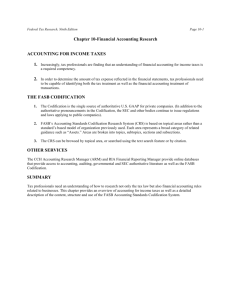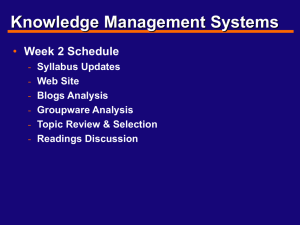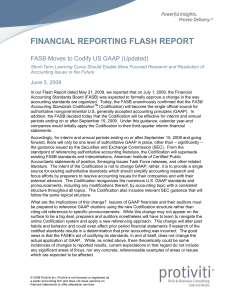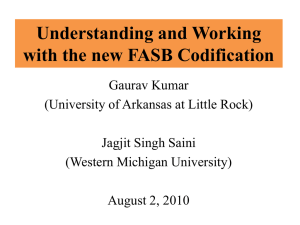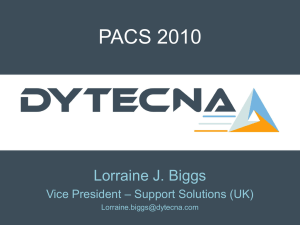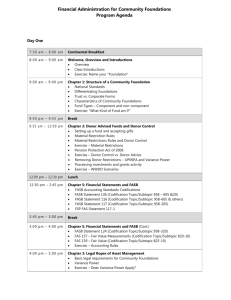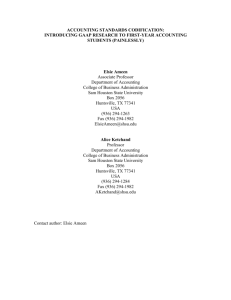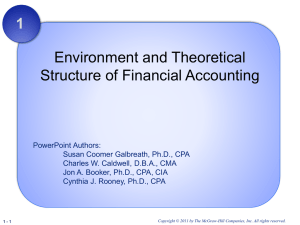Codification - The Impact on the Financial Statement
advertisement
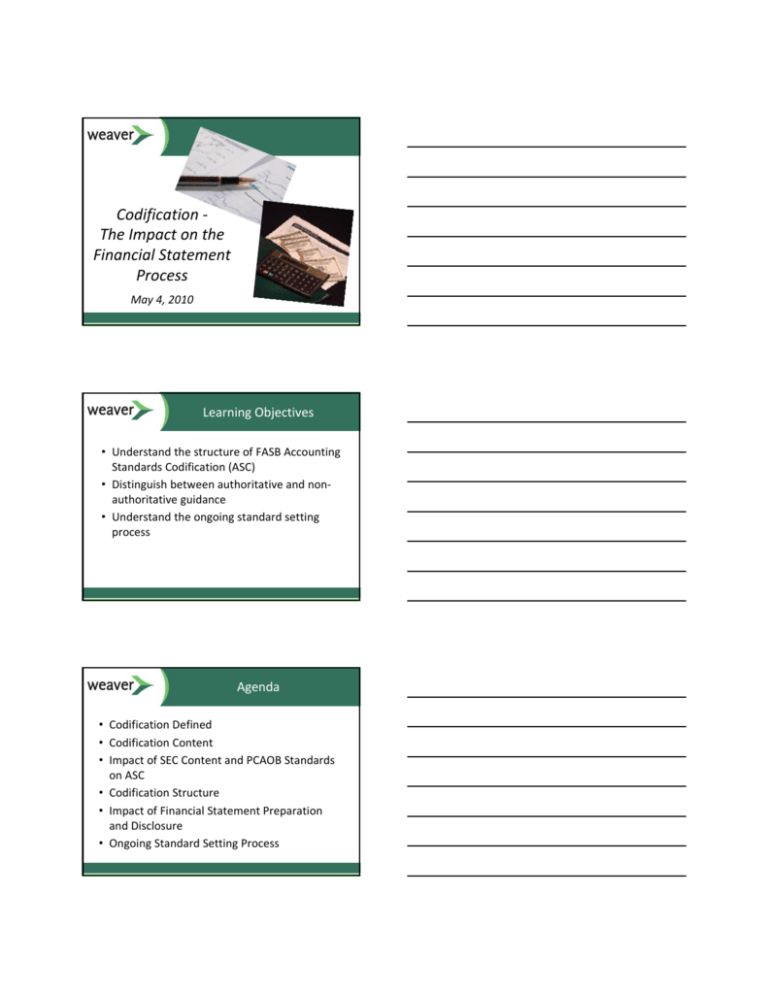
Codification ‐ The Impact on the Financial Statement Process May 4, 2010 Learning Objectives • Understand the structure of FASB Accounting Standards Codification (ASC) • Distinguish between authoritative and non‐ authoritative guidance • Understand the ongoing standard setting process Agenda • Codification Defined • Codification Content • Impact of SEC Content and PCAOB Standards on ASC • Codification Structure • Impact of Financial Statement Preparation and Disclosure • Ongoing Standard Setting Process Codification Defined • The FASB Accounting Standards CodificationTM is the single source of authoritative U.S. GAAP, except for SEC guidance (excludes governmental accounting) • Eliminates GAAP hierarchy and replaces it with authoritative and non‐authoritative guidance • Organized into a topical format • Attempt to reduce the complexity of accounting standards and to facilitate international convergence Codification Defined – Cont’d • Incorporates SEC rules and interpretive releases as authoritative for SEC registrants • Not intended to change US GAAP • Supersedes existing sources of GAAP – Any prior sources of US GAAP not included or grandfathered are not considered authoritative • Only affects US non‐governmental accounting standards Codification Content • Standards included in levels a‐d of the previous US GAAP hierarchy • FASB, EITF, DIG, APB, and AICPA guidance • Certain guidance that was not previously considered authoritative GAAP has been included in the codification and made authoritative Codification Content – Cont’d • AICPA Technical Inquiry Services guidance for software revenue recognition has been elevated for non‐SEC registrants (Section 5100 paragraphs 38‐76) • Cross references to pre‐codification standards Codification Content – Cont’d • Excluded: – Content deemed redundant or non‐authoritative – Guidance for non‐US GAAP such as OCBOA – Governmental accounting standards – Standards that were outdated or superseded on December 31, 2008 – Grandfathered material such as pooling of interests Impact of SEC Content and PCAOB Standards on ASC • SEC Guidance – Included in the codification for purposes of convenience – Guidance included in the codification is not complete – SEC continues to have authority for updating and amending SEC accounting guidance – Guidance preceded by an “S” – SEC sections include the full text of the relevant guidance – The full population of SEC rules, regulations, interpretive releases and staff guidance is not included in the Codification – Reference should always be made to the specific SEC rules and not the Codification Codification Structure • Areas – Topics • Subtopics –Sections »Subsections Codification Structure – Cont’d • Areas – Groupings of topics to allow for ease of use and are not part of the numerical referencing system – Topical organization of information • Topics – Broad categorization of related content and correlate with IFRS / IAS standards – Example: The Liability “Area” includes “Topics” such as Deferred Revenue, Contingencies, and Debt (ASC 405) Codification Structure – Cont’d • Sub‐Topics – Subsets of topics – General distinguished by type or scope – Example: A subtopic of the Liability topic is Extinguishment of Liabilities (ASC 405‐20) • Sections – Relate to the nature of the content in the sub‐topic – Numbering is consistent throughout the Codification: Section 15 is always Scope, section 50 is always Disclosure – Sections correlate with IFRS / IAS sections Codification Structure – Cont’d • Subsections – Further segregates information into specific areas – Example: Lessees is a subsection of the Leases topic (840) – Example Codification Reference: 840‐20‐50‐1 is the reference for the first paragraph under operating lease (20) disclosures (50) Codification Structure – Cont’d Codification Structure – Cont’d Topic Subtopic Sections SEC Content Access and Registration • Access through RIA, ARM, etc. • Registration options – Professional view (paid access) allows for greatest functionality and options. – Academic view allows free access to the professional view for accounting program faculty and students. – Basic view (free access) available to everyone with limited functionality but access to all relevant guidance. – www.asc.fasb.org Impact on Financial Statement Preparation and Disclosure • Accounting guidance referencing – Referencing convention is to refer to the “FASB ASC” followed by the topic, subtopic, section, and paragraph – Example: FASB ASC 840‐20‐50‐1 for specific disclosure requirements related to operating leases from the lessee’s standpoint – All legacy financial statement references should be updated to reflect the new Codification – Accounting policy documents should be updated to properly reflect the new Codification Ongoing Standard Setting • Codification updates will be made through Accounting Standards Updates (ASUs) issued by the Financial Accounting Standards Board • ASUs will include: – Background information – Basis for conclusions – Update instructions • ASUs are not authoritative upon release • ASUs are accessible through the FASB website • ASUs are numbered using a sequential identifier based on the year issued (e.g. 2010‐01) Ongoing Standard Setting • There are no changes to FASB due process • Guidance will continue to be open for comment in the same manner as pre‐ codification guidance through exposure drafts • Exposure drafts contain all proposed amendments to the Codification • EITF will deliberate issues on its agenda and reach consensuses‐for‐exposure in the same manner Q&A Questions? Questions? Presented by: David Rook, CPA Partner, Assurance Services 24 Greenway Plaza Suite 1800 Houston, Texas 77046 713.850.8787 David.Rook@WeaverLLP.com
